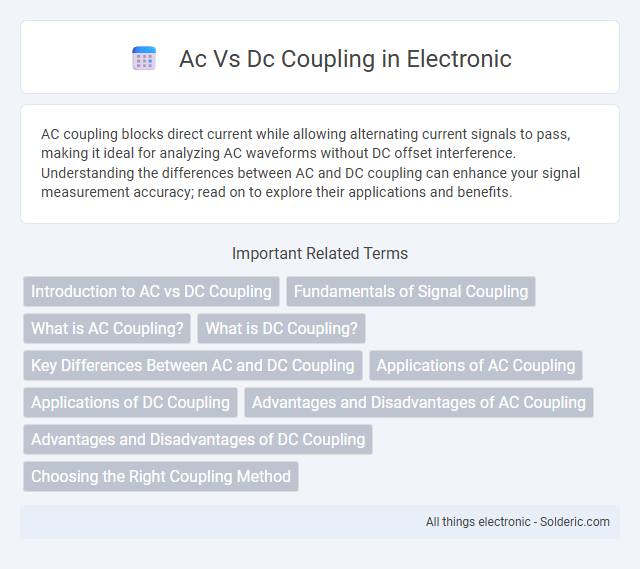AC coupling blocks direct current while allowing alternating current signals to pass, making it ideal for analyzing AC waveforms without DC offset interference. Understanding the differences between AC and DC coupling can enhance your signal measurement accuracy; read on to explore their applications and benefits.
Comparison Table
| Feature | AC Coupling | DC Coupling |
|---|---|---|
| Signal Type | Alternating current only | Both alternating and direct current |
| Frequency Response | Blocks DC, passes AC signals | Passes DC and AC signals |
| Use Case | Removing DC offset, measuring AC waveforms | Measuring true voltage levels including DC offset |
| Circuit Element | Capacitor in series | Direct electrical connection |
| Output Bias | Zero average voltage | Maintains original DC level |
| Measurement Accuracy | Not suitable for DC level detection | Accurate for DC and AC signals |
Introduction to AC vs DC Coupling
AC coupling blocks DC components in a signal, allowing only the alternating current (AC) variations to pass through, which is essential for measuring AC signals without interference from DC offsets. DC coupling, on the other hand, allows both AC and DC components to pass, providing a complete representation of the signal, critical for applications requiring accurate voltage measurements, including DC levels. Understanding the distinction between AC and DC coupling is vital for selecting the appropriate method in oscilloscopes, signal processing, and communication systems.
Fundamentals of Signal Coupling
AC coupling allows signals to pass by blocking the DC component, which is essential for analyzing varying signals without baseline offset. DC coupling transmits both AC and DC components, preserving the entire signal waveform for accurate measurement of steady-state levels. Choosing the right coupling mode ensures your instrument accurately captures the signal's fundamental characteristics based on the measurement context.
What is AC Coupling?
AC coupling refers to a method used in electronic circuits to block direct current (DC) components while allowing alternating current (AC) signals to pass through. This technique is commonly implemented using a capacitor in series with the signal path, effectively removing any DC offset that could distort measurements or signal processing. AC coupling is essential in applications such as oscilloscopes and audio equipment where only the varying part of the signal needs to be analyzed or transmitted.
What is DC Coupling?
DC coupling allows direct transmission of both alternating current (AC) and direct current (DC) signals without blocking any frequency components, preserving the true waveform of your input signal. It connects the input and output stages directly through a conductor, enabling accurate measurement of low-frequency or steady-state signals. This method is essential in applications like sensor data acquisition and audio equipment where capturing the full signal, including any DC offset, is critical.
Key Differences Between AC and DC Coupling
AC coupling blocks direct current components by using a capacitor, allowing only alternating current signals to pass through, ideal for removing DC offset in measurement systems. DC coupling permits both direct and alternating current signals to pass, preserving the original waveform with its DC level, which is crucial for applications requiring accurate voltage measurement. The choice between AC and DC coupling impacts signal fidelity, noise reduction, and the ability to analyze different frequency components in electronic circuits and oscilloscopes.
Applications of AC Coupling
AC coupling is widely used in signal processing and communication systems to block DC components while allowing AC signals to pass. It is essential in oscilloscope measurements, audio equipment, and radio frequency circuits where isolating the AC signal from any DC offset improves accuracy and prevents distortion. Your devices benefit from AC coupling by ensuring cleaner signal transmission and enhancing overall performance in dynamic signal environments.
Applications of DC Coupling
DC coupling enables accurate measurement and transmission of both AC and DC signals, making it essential in applications like sensor data acquisition, telecommunications, and power electronics. Your instrumentation can capture true signal waveforms without distortion, crucial for battery monitoring, photovoltaic systems, and low-frequency signal analysis. This ensures precision in detecting offset voltages and slowly varying signals that AC coupling might filter out.
Advantages and Disadvantages of AC Coupling
AC coupling blocks DC components, allowing you to focus on varying signal fluctuations, which is advantageous in eliminating offset and low-frequency noise for precise measurements. It can distort or remove slow-changing signals and cause baseline shifts, posing a disadvantage when analyzing signals with significant DC content or very low frequencies. This makes AC coupling ideal for applications requiring isolation from DC bias but less suitable for capturing absolute signal levels.
Advantages and Disadvantages of DC Coupling
DC coupling allows continuous measurement of both AC and DC signals, making it essential for applications requiring accurate low-frequency or steady-state voltage analysis. This method offers advantages such as preserving signal integrity and enabling precise waveform capture without distortion from capacitive elements. However, DC coupling can introduce baseline drift and saturation in systems with large DC offsets, requiring careful design to avoid measurement errors and potential damage to sensitive components.
Choosing the Right Coupling Method
Choosing the right coupling method depends on the signal type and measurement objectives; AC coupling blocks DC components, allowing analysis of small AC signals superimposed on large DC offsets, while DC coupling preserves both AC and DC signals for accurate amplitude and waveform representation. Your decision impacts measurement accuracy--use AC coupling for noise reduction and DC coupling for full signal capture. Understanding the difference ensures optimal results in oscilloscopes, amplifiers, and signal analyzers.
ac vs dc coupling Infographic

 solderic.com
solderic.com